Light MERCEDES-BENZ GL-Class 2014 X166 User Guide
[x] Cancel search | Manufacturer: MERCEDES-BENZ, Model Year: 2014, Model line: GL-Class, Model: MERCEDES-BENZ GL-Class 2014 X166Pages: 462, PDF Size: 32.46 MB
Page 20 of 462
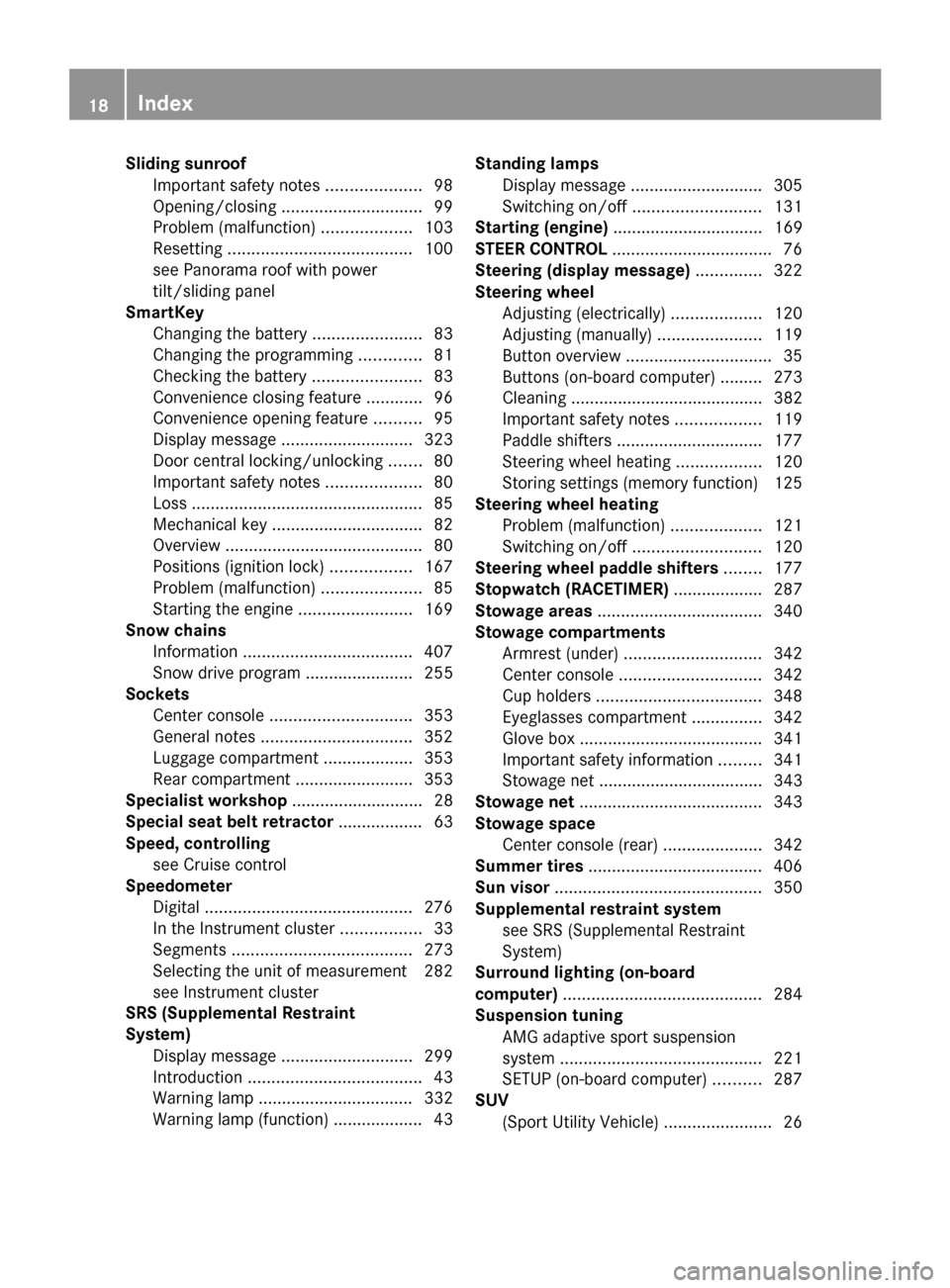
Sliding sunroof
Important safety notes ....................98
Opening/closing .............................. 99
Problem (malfunction) ...................103
Resetting ....................................... 100
see Panorama roof with power
tilt/sliding panel
SmartKey
Changing the battery .......................83
Changing the programming .............81
Checking the battery .......................83
Convenience closing feature ............96
Convenience opening feature ..........95
Display message ............................ 323
Door central locking/unlocking .......80
Important safety notes ....................80
Loss ................................................. 85
Mechanical key ................................ 82
Overview .......................................... 80
Positions (ignition lock) .................167
Problem (malfunction) .....................85
Starting the engine ........................169
Snow chains
Information .................................... 407
Snow drive program ....................... 255
Sockets
Center console .............................. 353
General notes ................................ 352
Luggage compartment ...................353
Rear compartment .........................353
Specialist workshop ............................ 28
Special seat belt retractor .................. 63
Speed, controlling see Cruise control
Speedometer
Digital ............................................ 276
In the Instrument cluster .................33
Segments ...................................... 273
Selecting the unit of measurement 282
see Instrument cluster
SRS (Supplemental Restraint
System)
Display message ............................ 299
Introduction ..................................... 43
Warning lamp ................................. 332
Warning lamp (function) ................... 43 Standing lamps
Display message ............................ 305
Switching on/off ........................... 131
Starting (engine) ................................ 169
STEER CONTROL .................................. 76
Steering (display message) ..............322
Steering wheel Adjusting (electrically) ...................120
Adjusting (manually). .....................119
Button overview ............................... 35
Buttons (on-board computer) ......... 273
Cleaning ......................................... 382
Important safety notes ..................119
Paddle shifters ............................... 177
Steering wheel heating ..................120
Storing settings (memory function) 125
Steering wheel heating
Problem (malfunction) ...................121
Switching on/off ........................... 120
Steering wheel paddle shifters ........177
Stopwatch (RACETIMER) ................... 287
Stowage areas ................................... 340
Stowage compartments Armrest (under) ............................. 342
Center console .............................. 342
Cup holders ................................... 348
Eyeglasses compartment ...............342
Glove box ...................................... .341
Important safety information .........341
Stowage net ................................... 343
Stowage net ....................................... 343
Stowage space Center console (rear) .....................342
Summer tires ..................................... 406
Sun visor ............................................ 350
Supplemental restraint system see SRS (Supplemental Restraint
System)
Surround lighting (on-board
computer) .......................................... 284
Suspension tuning AMG adaptive sport suspension
system ........................................... 221
SETUP (on-board computer) ..........287
SUV
(Sport Utility Vehicle) .......................2618
Index
Page 34 of 462
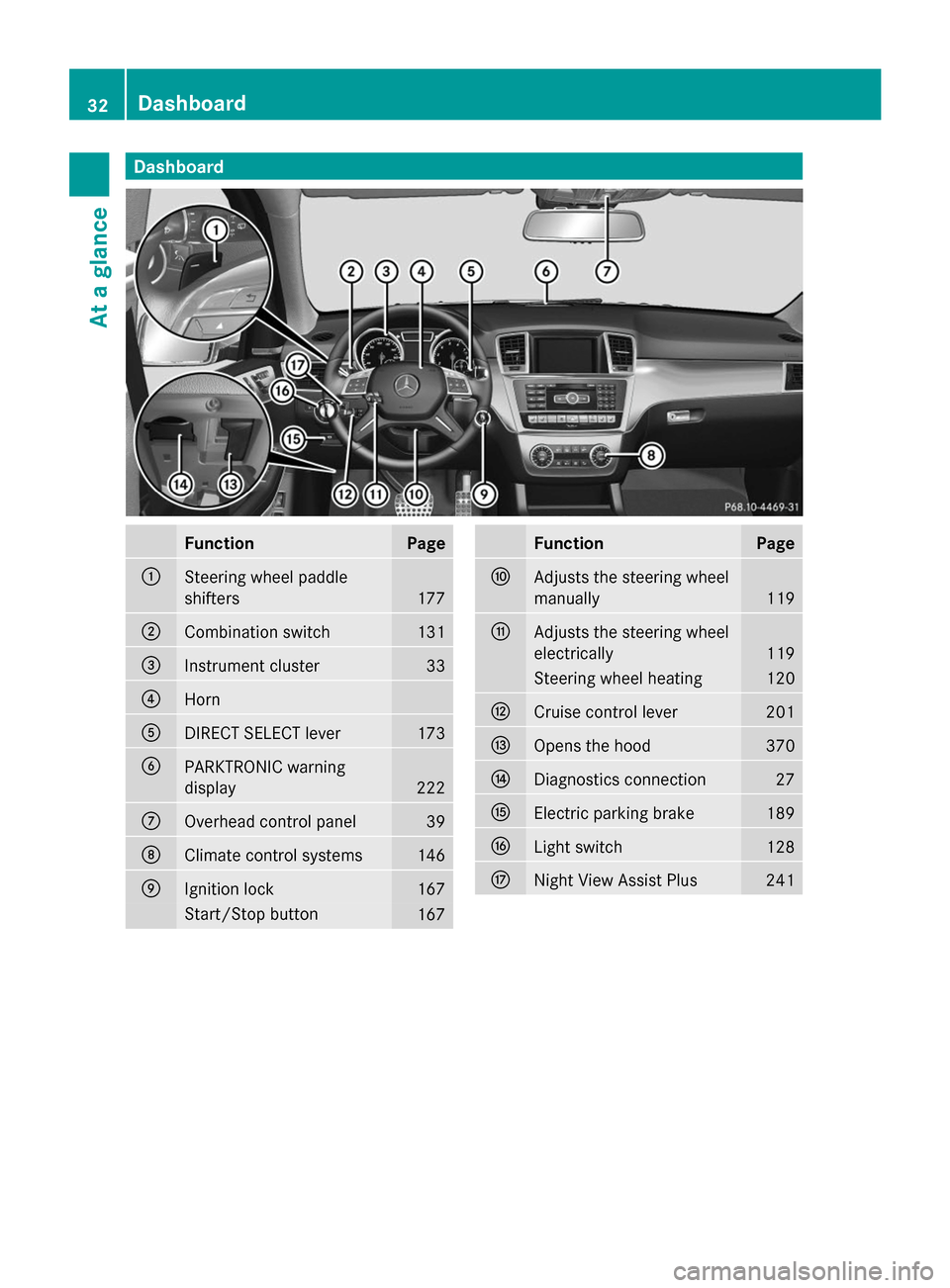
Dashboard
Function Page
:
Steering wheel paddle
shifters
177
;
Combination switch 131
=
Instrument cluster 33
?
Horn
A
DIRECT SELECT lever 173
B
PARKTRONIC warning
display
222
C
Overhead control panel 39
D
Climate control systems 146
E
Ignition lock 167
Start/Stop button
167 Function Page
F
Adjusts the steering wheel
manually
119
G
Adjusts the steering wheel
electrically
119
Steering wheel heating 120
H
Cruise control lever 201
I
Opens the hood 370
J
Diagnostics connection 27
K
Electric parking brake 189
L
Light switch 128
M
Night View Assist Plus 24132
Dashboa
rdAt a glance
Page 35 of 462
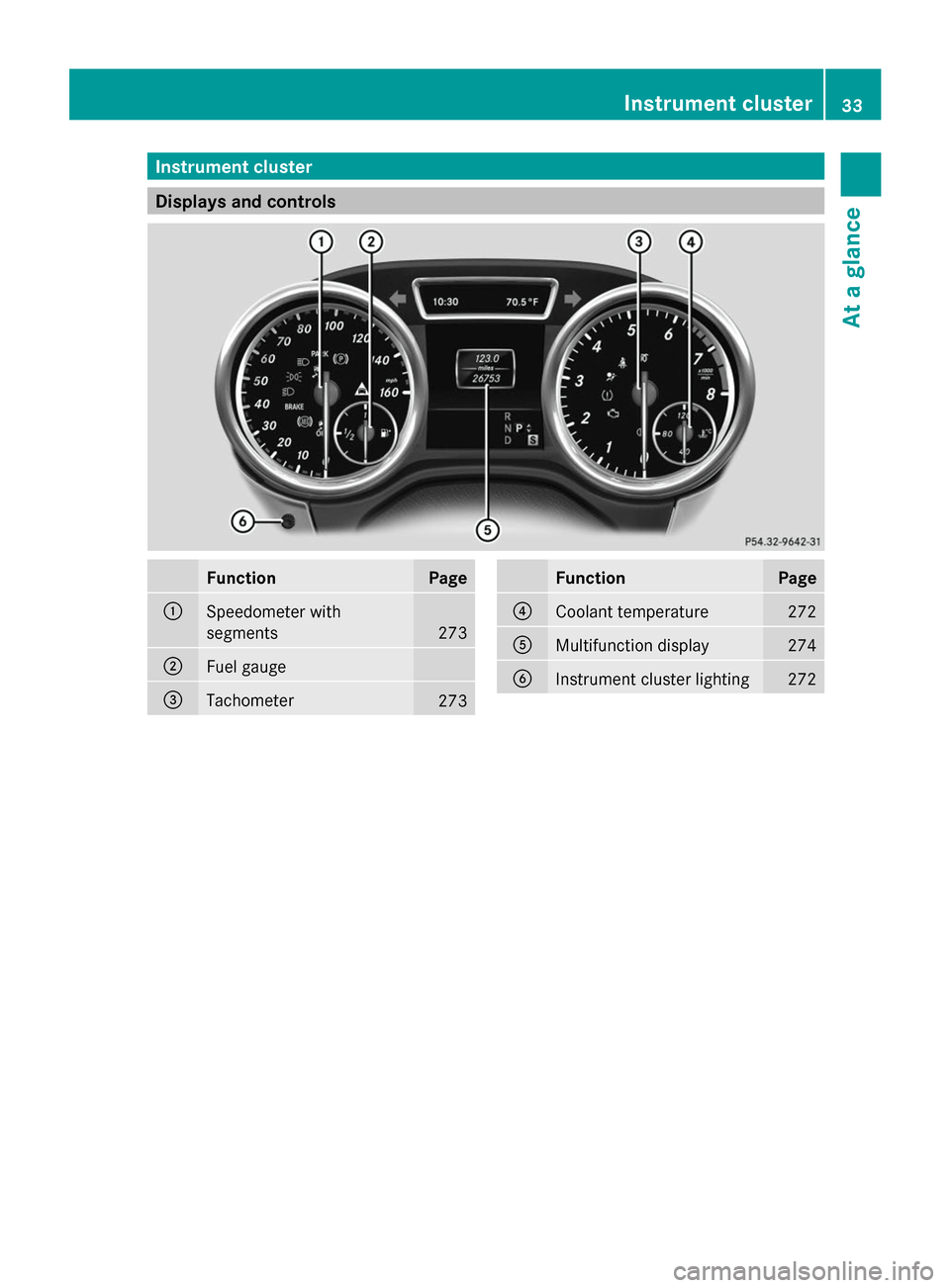
Instrument cluster
Displays and controls
Function Page
:
Speedometer with
segments
273
;
Fuel gauge
=
Tachometer
273 Function Page
?
Coolant temperature 272
A
Multifunction display 274
B
Instrument cluster lighting 272Instrument cluster
33At a glance
Page 39 of 462

Center console, lower section
i
Vehicles with the ON&OFFROAD package Function Page
F
Cup holder 348
Ashtray 351
Cigarette lighter 352
Socket 352
G
COMAND controller; see
the separate operating
instructions
H
d
ON&OFFROAD menu
button 262
I
+
LOW RANGE off-road
gear 259 Function Page
J
Á
Level control 212
K
Ã
DSR (Downhill Speed
Regulation) 256
L
p
Manual drive program 178
M
Selector wheel for on-road
programs
253
Selector wheel for off-road
programs
258
N
Stowage compartment with
Media Interface
342Center console
37At a glance
Page 40 of 462
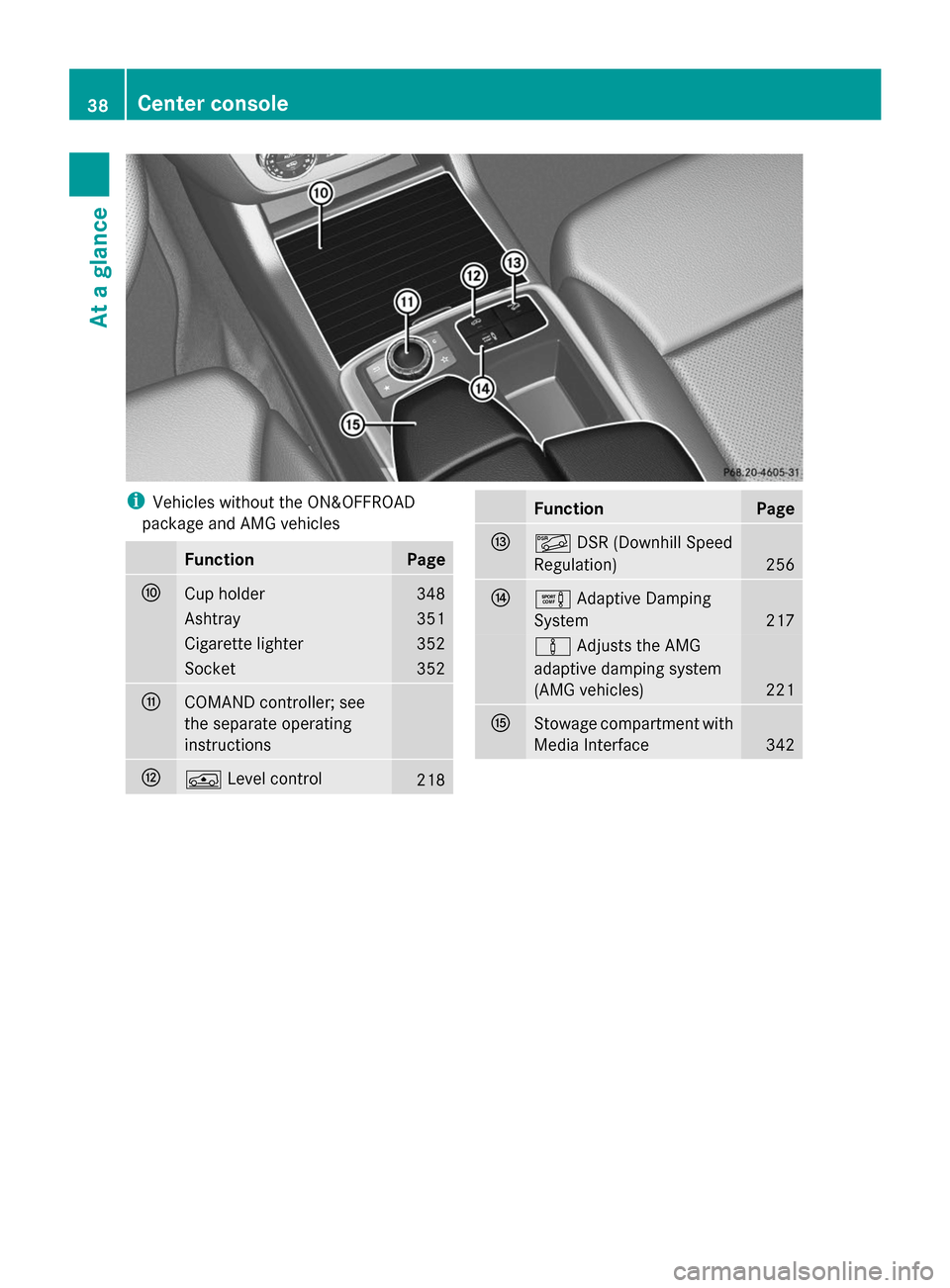
i
Vehicles without the ON&OFFROAD
package and AMG vehicles Function Page
F
Cup holder 348
Ashtray 351
Cigarette lighter 352
Socket 352
G
COMAND controller; see
the separate operating
instructions
H
Á
Level control 218 Function Page
I
Ã
DSR (Downhill Speed
Regulation) 256
J
e
Adaptive Damping
System 217
à
Adjusts the AMG
adaptive damping system
(AMG vehicles) 221
K
Stowage compartment with
Media Interface
34238
Center consoleAt a glance
Page 41 of 462
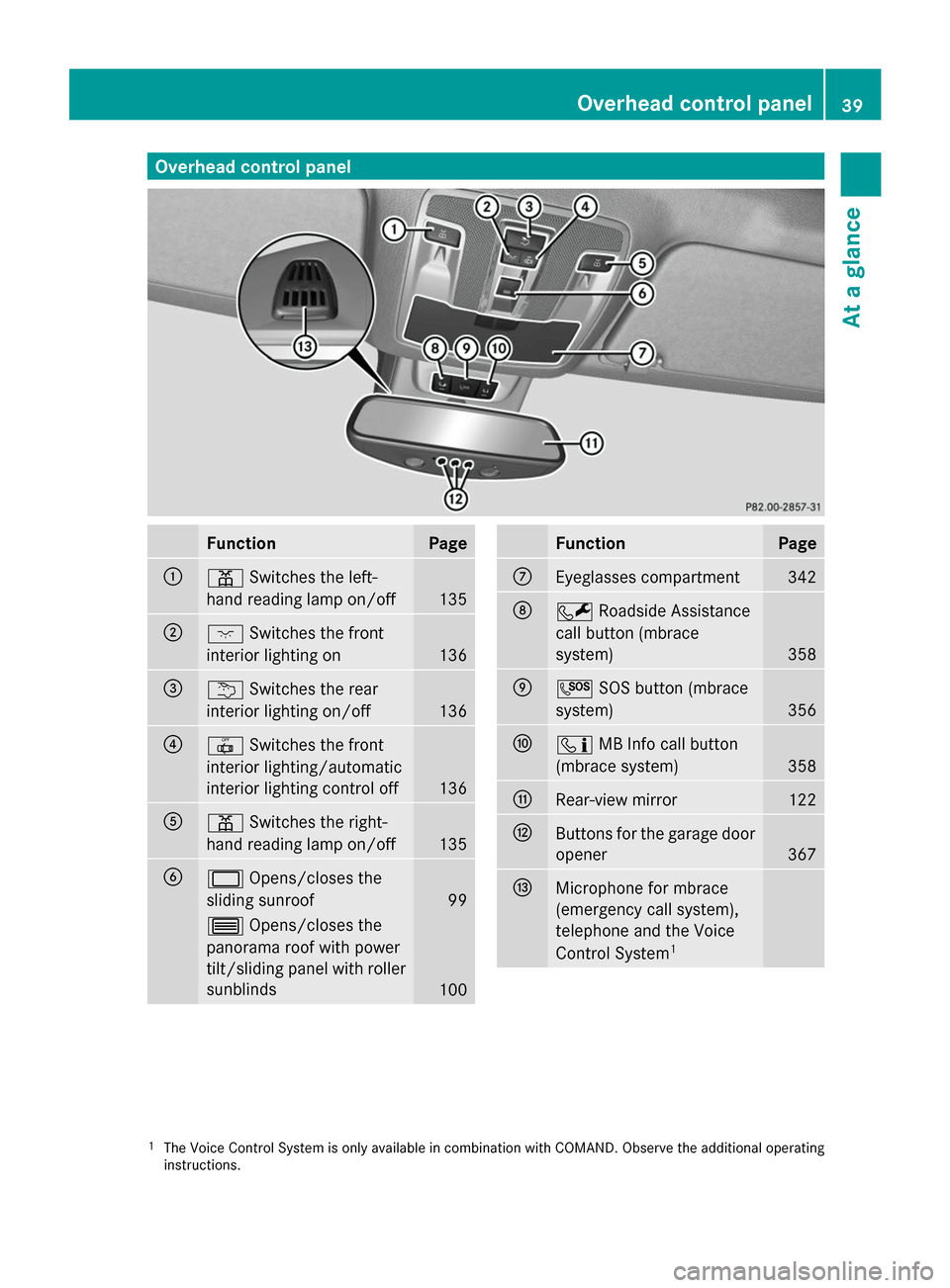
Overhead control panel
Function Page
:
p
Switches the left-
hand reading lamp on/off 135
;
c
Switches the front
interior lighting on 136
=
u
Switches the rear
interior lighting on/off 136
?
|
Switches the front
interior lighting/automatic
interior lighting control off 136
A
p
Switches the right-
hand reading lamp on/off 135
B
2
Opens/closes the
sliding sunroof 99
3
Opens/closes the
panorama roof with power
tilt/sliding panel with roller
sunblinds 100 Function Page
C
Eyeglasses compartment 342
D
F
Roadside Assistance
call button (mbrace
system) 358
E
G
SOS button (mbrace
system) 356
F
ï
MB Info call button
(mbrace system) 358
G
Rear-view mirror 122
H
Buttons for the garage door
opener
367
I
Microphone for mbrace
(emergency call system),
telephone and the Voice
Control System
1 1
The Voice Control System is only available in combination with COMAND. Observe the additional operating
instructions. Overhead control panel
39At a glance
Page 44 of 462
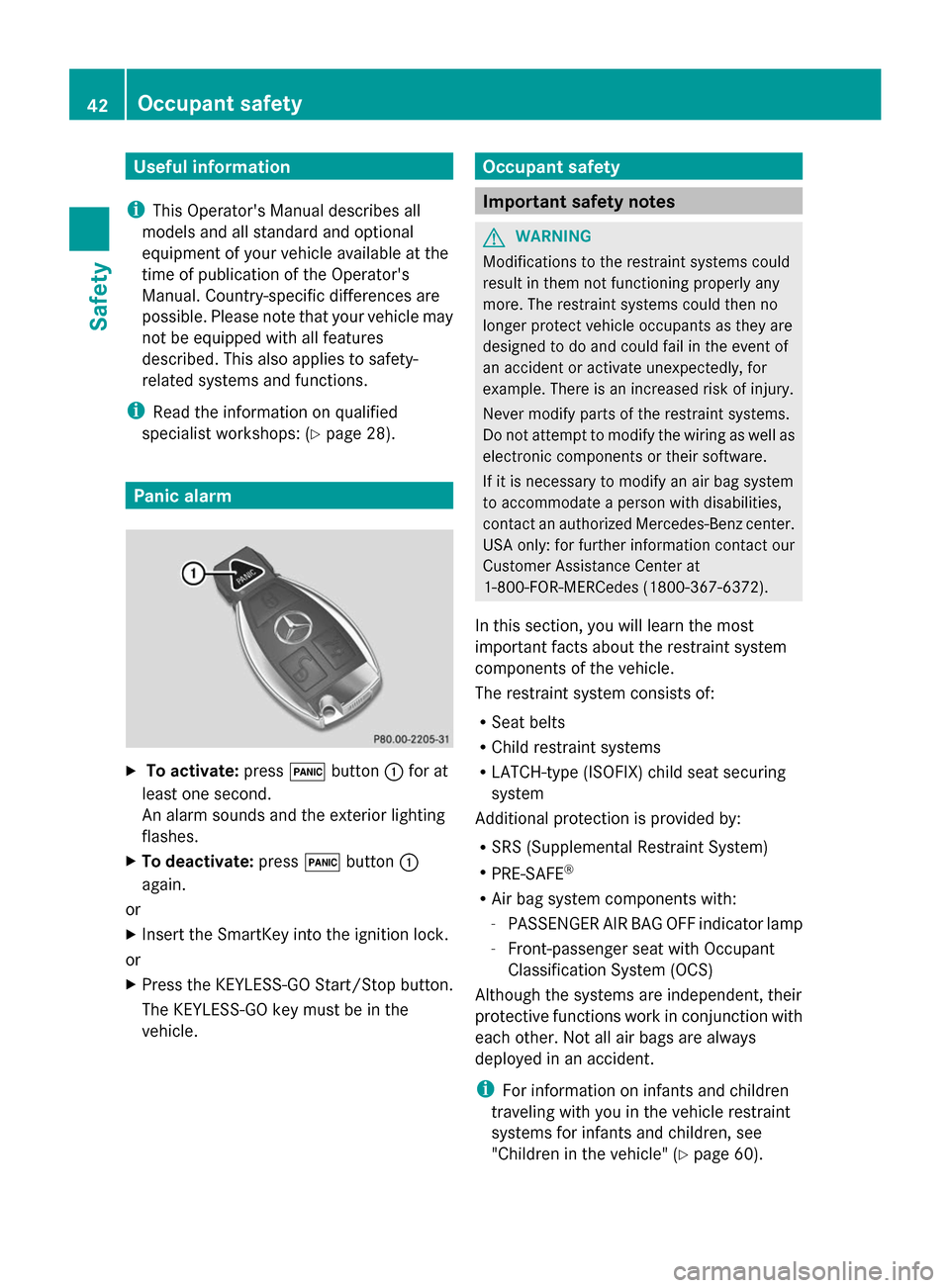
Useful information
i This Operator's Manual describes all
models and all standard and optional
equipment of your vehicle available at the
time of publication of the Operator's
Manual. Country-specific differences are
possible. Please note that your vehicle may
not be equipped with all features
described. This also applies to safety-
related systems and functions.
i Read the information on qualified
specialist workshops: (Y page 28).Panic alarm
X
To activate: press!button :for at
least one second.
An alarm sounds and the exterior lighting
flashes.
X To deactivate: press!button :
again.
or
X Insert the SmartKey into the ignition lock.
or
X Press the KEYLESS-GO Start/Stop button.
The KEYLESS-GO key must be in the
vehicle. Occupant safety
Important safety notes
G
WARNING
Modifications to the restraint systems could
result in them not functioning properly any
more. The restraint systems could then no
longer protect vehicle occupants as they are
designed to do and could fail in the event of
an accident or activate unexpectedly, for
example. There is an increased risk of injury.
Never modify parts of the restraint systems.
Do not attempt to modify the wiring as well as
electronic components or their software.
If it is necessary to modify an air bag system
to accommodate a person with disabilities,
contact an authorized Mercedes-Benz center.
USA only: for further information contact our
Customer Assistance Center at
1-800-FOR-MERCedes (1800-367-6372).
In this section, you will learn the most
important facts about the restraint system
components of the vehicle.
The restraint system consists of:
R Seat belts
R Child restraint systems
R LATCH-type (ISOFIX) child seat securing
system
Additional protection is provided by:
R SRS (Supplemental Restraint System)
R PRE-SAFE ®
R Air bag system components with:
-PASSENGER AIR BAG OFF indicator lamp
- Front-passenger seat with Occupant
Classification System (OCS)
Although the systems are independent, their
protective functions work in conjunction with
each other. Not all air bags are always
deployed in an accident.
i For information on infants and children
traveling with you in the vehicle restraint
systems for infants and children, see
"Children in the vehicle" (Y page 60).42
Occupant safetySafety
Page 45 of 462
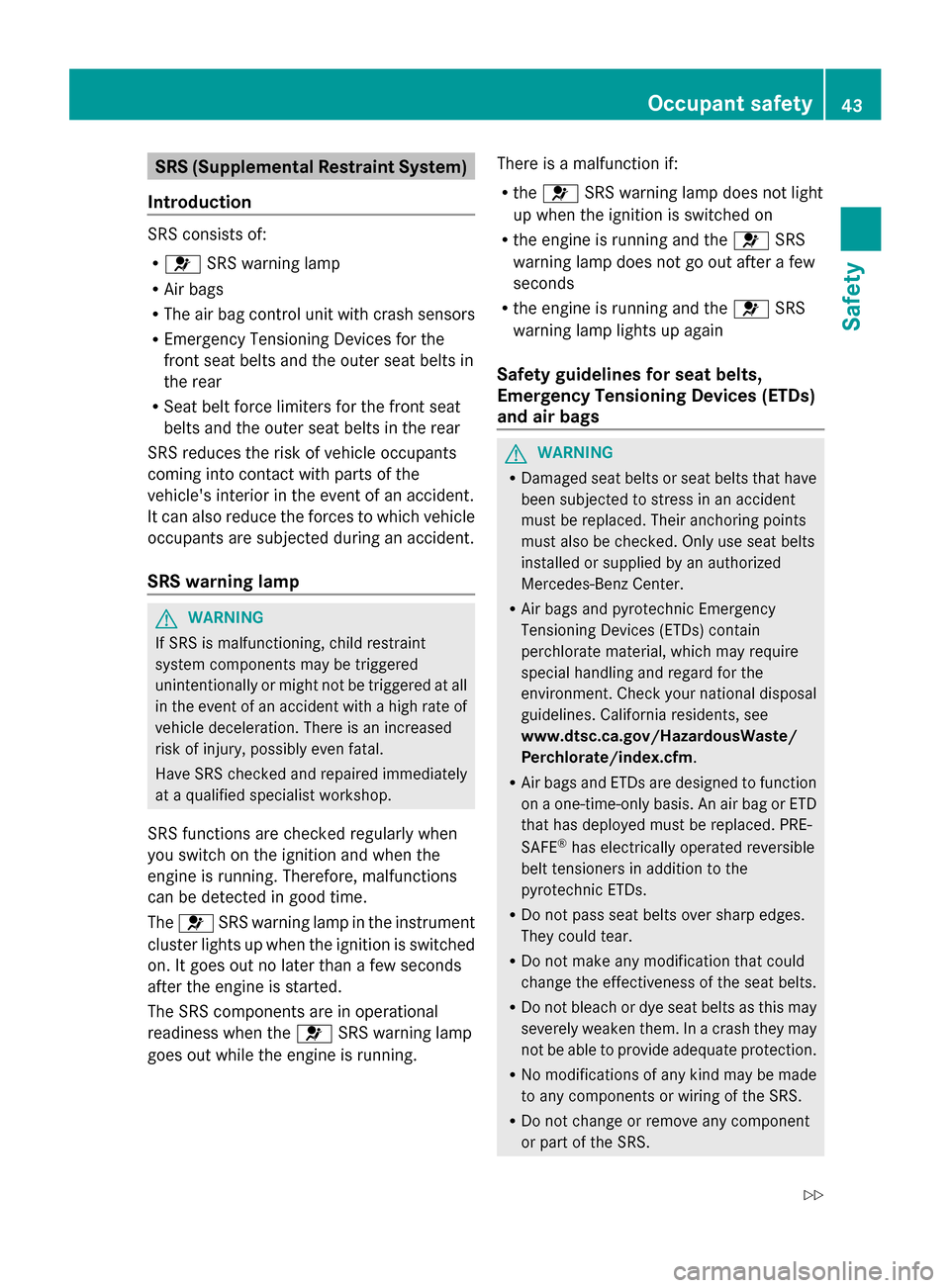
SRS (Supplemental Restraint System)
Introduction SRS consists of:
R
6 SRS warning lamp
R Air bags
R The air bag control unit with crash sensors
R Emergency Tensioning Devices for the
front seat belts and the outer seat belts in
the rear
R Seat belt force limiters for the front seat
belts and the outer seat belts in the rear
SRS reduces the risk of vehicle occupants
coming into contact with parts of the
vehicle's interior in the event of an accident.
It can also reduce the forces to which vehicle
occupants are subjected during an accident.
SRS warning lamp G
WARNING
If SRS is malfunctioning, child restraint
system components may be triggered
unintentionally or might not be triggered at all
in the event of an accident with a high rate of
vehicle deceleration. There is an increased
risk of injury, possibly even fatal.
Have SRS checked and repaired immediately
at a qualified specialist workshop.
SRS functions are checked regularly when
you switch on the ignition and when the
engine is running. Therefore, malfunctions
can be detected in good time.
The 6 SRS warning lamp in the instrument
cluster lights up when the ignition is switched
on. It goes out no later than a few seconds
after the engine is started.
The SRS components are in operational
readiness when the 6SRS warning lamp
goes out while the engine is running. There is a malfunction if:
R
the 6 SRS warning lamp does not light
up when the ignition is switched on
R the engine is running and the 6SRS
warning lamp does not go out after a few
seconds
R the engine is running and the 6SRS
warning lamp lights up again
Safety guidelines for seat belts,
Emergency Tensioning Devices (ETDs)
and air bags G
WARNING
R Damaged seat belts or seat belts that have
been subjected to stress in an accident
must be replaced. Their anchoring points
must also be checked. Only use seat belts
installed or supplied by an authorized
Mercedes-Benz Center.
R Air bags and pyrotechnic Emergency
Tensioning Devices (ETDs) contain
perchlorate material, which may require
special handling and regard for the
environment. Check your national disposal
guidelines. California residents, see
www.dtsc.ca.gov/HazardousWaste/
Perchlorate/index.cfm .
R Air bags and ETDs are designed to function
on a one-time-only basis. An air bag or ETD
that has deployed must be replaced. PRE-
SAFE ®
has electrically operated reversible
belt tensioners in addition to the
pyrotechnic ETDs.
R Do not pass seat belts over sharp edges.
They could tear.
R Do not make any modification that could
change the effectiveness of the seat belts.
R Do not bleach or dye seat belts as this may
severely weaken them. In a crash they may
not be able to provide adequate protection.
R No modifications of any kind may be made
to any components or wiring of the SRS.
R Do not change or remove any component
or part of the SRS. Occupant safety
43Safety
Z
Page 47 of 462

vehicle. In order to prevent potential
breathing difficulties, you should leave the
vehicle as soon as it is safe to do so. If you
have any breathing difficulty but cannot get
out of the vehicle after the air bag inflates,
then get fresh air by opening a window or
door. G
WARNING
In order to reduce the potential danger of
injuries caused during the deployment of the
front air bags, the driver and front passenger
must always be correctly seated and wear
their seat belts.
For maximum protection in the event of a
collision, you must always be in the normal
seat position with your back against the
backrest. Fasten your seat belt and make sure
that it is correctly positioned on your body.
As the air bag inflates with considerable
speed and force, a proper seating position
and correct positioning of the hands on the
steering wheel will help to keep you at a safe
distance from the air bag. Occupants who are
not wearing their seat belt, are not seated
properly or are too close to the air bag can be
seriously injured or killed by an air bag, as it
inflates with great force instantaneously:
R sit with the seat belt fastened correctly and
in a position that is as upright as possible
with your back against the backrest.
R move the driver's seat as far back as
possible, still permitting proper operation
of vehicle controls. The distance from the
center of the driver's chest to the center of
the air bag cover on the steering wheel
must be at least 10 inches (25 cm). You
should be able to accomplish this by
adjusting the seat and steering wheel. If
you have any difficulties, please contact an
authorized Mercedes-Benz Center.
R do not lean your head or chest close to the
steering wheel or dashboard.
R only hold the steering wheel on the outside.
Placing hands and arms inside the rim can
increase the risk and potential severity of hand/arm injury if the driver front air bag
inflates.
R adjust the front-passenger seat as far back
as possible from the dashboard when the
seat is occupied.
R occupants, especially children, should
never place their bodies or lean their heads
in the area of the door where the side
impact air bag inflates. This could result in
serious or fatal injuries should the side
impact air bag be deployed. Always sit as
upright as possible, wear the seat belt
properly and use an appropriately sized
infant restraint, toddler restraint or booster
seat recommended for the size and weight
of the child.
Failure to follow these instructions can result
in severe injuries to you or other occupants.
If you sell your vehicle, it is important that you
make the buyer aware of this safety
information. Be sure to give the buyer this
Operator's Manual.
If the air bags are deployed, you will hear a
bang, and a small amount of powder may also
be released. Only in rare cases will the bang
affect your hearing. The powder that is
released generally does not constitute a
health hazard and does not indicate that there
is a fire in the vehicle. The dust might cause
some temporary breathing difficulty for
people with asthma or other breathing
trouble. To avoid this, you may wish to get out
of the vehicle as soon as it is safe to do so.
You can also open the window to allow fresh
air to enter the vehicle interior. The 6SRS
warning lamp lights up.
The air bag installation locations are
identified by the AIR BAG symbol.
The air bags are deployed if the air bag control
unit detects the need for deployment. Only in
the event of such a situation will the air bags
provide their supplemental protection.
If the driver and front passenger do not wear
their seat belts, it is not possible for the air Occupant safety
45Safety Z
Page 48 of 462
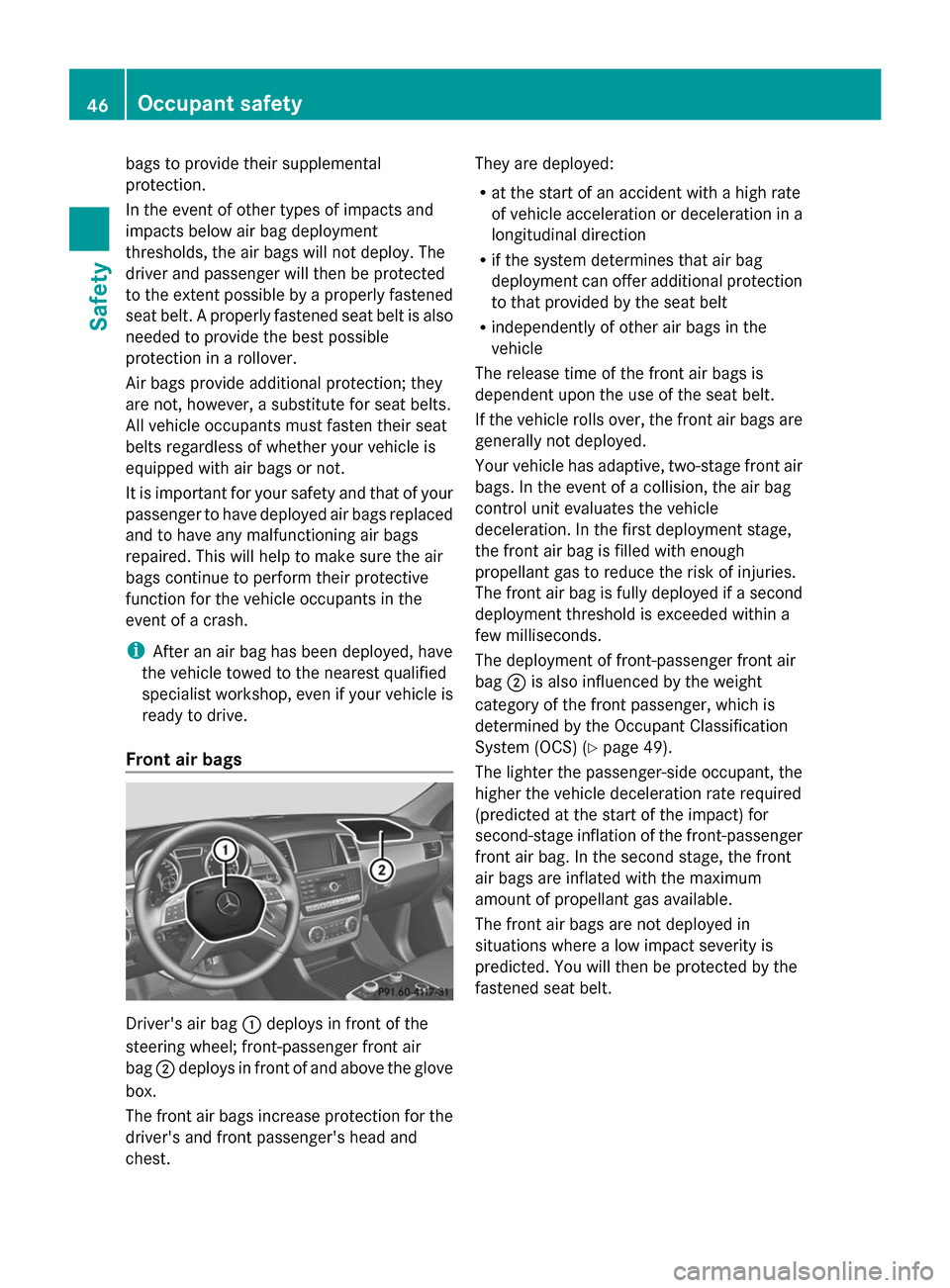
bags to provide their supplemental
protection.
In the event of other types of impacts and
impacts below air bag deployment
thresholds, the air bags will not deploy. The
driver and passenger will then be protected
to the extent possible by a properly fastened
seat belt. A properly fastened seat belt is also
needed to provide the best possible
protection in a rollover.
Air bags provide additional protection; they
are not, however, a substitute for seat belts.
All vehicle occupants must fasten their seat
belts regardless of whether your vehicle is
equipped with air bags or not.
It is important for your safety and that of your
passenger to have deployed air bags replaced
and to have any malfunctioning air bags
repaired. This will help to make sure the air
bags continue to perform their protective
function for the vehicle occupants in the
event of a crash.
i After an air bag has been deployed, have
the vehicle towed to the nearest qualified
specialist workshop, even if your vehicle is
ready to drive.
Front air bags Driver's air bag
:deploys in front of the
steering wheel; front-passenger front air
bag ;deploys in front of and above the glove
box.
The front air bags increase protection for the
driver's and front passenger's head and
chest. They are deployed:
R
at the start of an accident with a high rate
of vehicle acceleration or deceleration in a
longitudinal direction
R if the system determines that air bag
deployment can offer additional protection
to that provided by the seat belt
R independently of other air bags in the
vehicle
The release time of the front air bags is
dependent upon the use of the seat belt.
If the vehicle rolls over, the front air bags are
generally not deployed.
Your vehicle has adaptive, two-stage front air
bags. In the event of a collision, the air bag
control unit evaluates the vehicle
deceleration. In the first deployment stage,
the front air bag is filled with enough
propellant gas to reduce the risk of injuries.
The front air bag is fully deployed if a second
deployment threshold is exceeded within a
few milliseconds.
The deployment of front-passenger front air
bag ;is also influenced by the weight
category of the front passenger, which is
determined by the Occupant Classification
System (OCS) (Y page 49).
The lighter the passenger-side occupant, the
higher the vehicle deceleration rate required
(predicted at the start of the impact) for
second-stage inflation of the front-passenger
front air bag. In the second stage, the front
air bags are inflated with the maximum
amount of propellant gas available.
The front air bags are not deployed in
situations where a low impact severity is
predicted. You will then be protected by the
fastened seat belt. 46
Occupant safetySafety